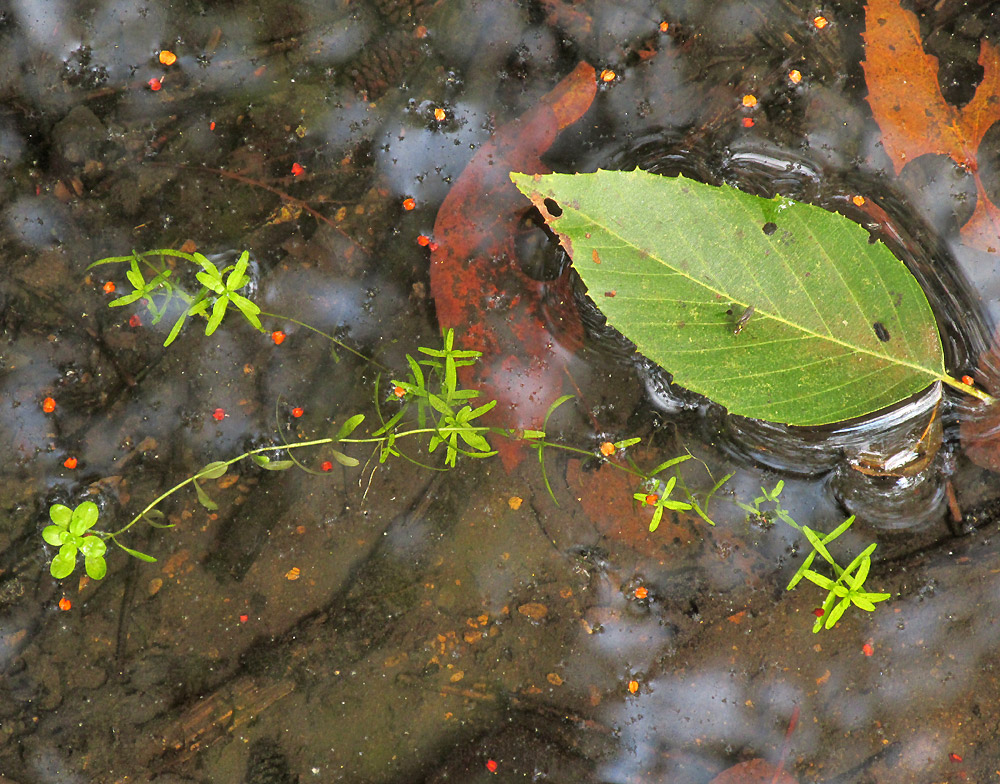Excerpts from Jim Conrad's
Naturalist Newsletter
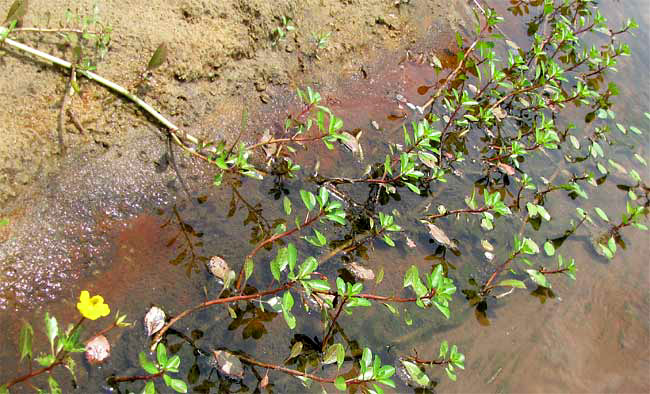
from the the July 7, 2008 Newsletter, issued from the forest near Natchez, Mississippi; elevation ~400ft (120m), ~N31.47°, ~W91.29°:
FLOATING PRIMROSE WILLOWS
Along nearby Sandy Creek an aquatic plant is flowering nowadays with attractive yellow blossoms, as shown above.
The plant, known as Floating Primrose Willow, LUDWIGIA PEPLOIDES, of the Evening Primrose Family, produces stems eight feet long and longer that float atop the water, trailing downstream as it branches and holds its leaves, flowers and fruits above water. At the picture's top left you see a stem stranded atop a sandbar by dropping water. A flower close-up is below:
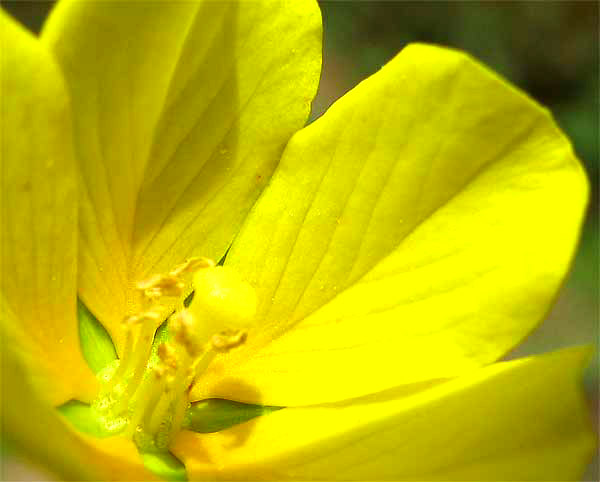
In the flower picture you see ten stamens of various lengths clustered around a columnar style topped by the blunt, pollen-receiving stigma. You don't see an ovary, which will ripen into a fruit, because the ovary lies below the parts visible in the picture, enclosed in the "calyx tube" below the petals This makes the ovary "inferior," which is nice to know because most flowers produce their ovaries above the petals and stamen point-of-insertion, and are "superior."
On the banks of Sandy Creek, Floating Primrose Willow presents itself as a pretty and interesting wildflower whose yellow blossoms stand out in early-summer's almost-monotonously green landscape. However, the species may have a questionable background. First, because it's distributed across the southern US clear to California, as well as throughout South America and Australia, it's unclear whether it's a native to here. But what is indeed clear is that in some places it's making a pest of itself by forming dense mats in lakes, ponds and canals.
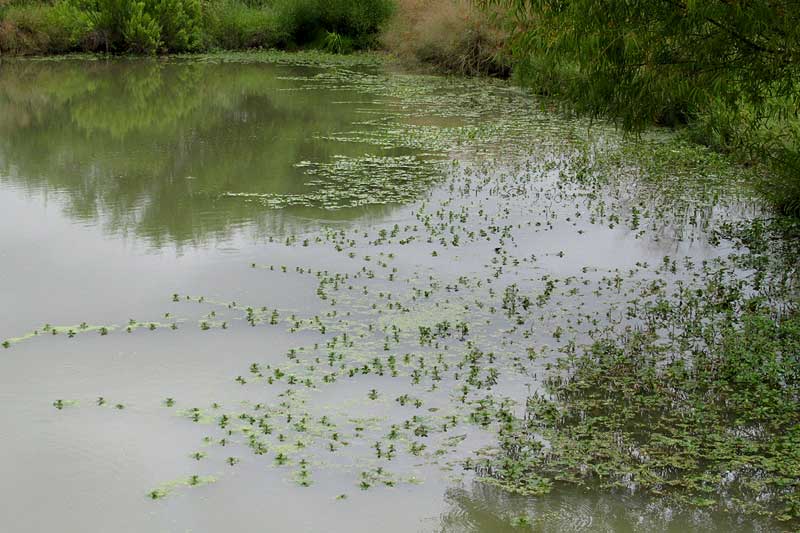
from the September 28, 2014 Newsletter issued from the Frio Canyon Nature Education Center in the valley of the Dry Frio River in northern Uvalde County, southwestern Texas, on the southern border of the Edwards Plateau; elevation ~1750m (~5750 ft); N29.62°, W99.86°; USA
FLOATING PRIMROSE-WILLOW
In a treatment pond in Cook's Sough Nature Park on Uvalde's south side, all summer I've been watching a certain population of aquatic plants grow and grow, waiting for their pretty yellow flowers. However, now in early fall when I'm preparing to leave Texas, still there are no flowers, so I'm profiling this plant despite its flowerless state, just because it's something worth seeing. That's it above.
I'm not the only one to notice the plant's advance across the pond, for along the banks someone has dragged in several bushels of it and dumped it into a heap... where the leafy stems seem to be thriving as well as in the water. But, still, no flowers are being produced.
I've been expecting yellow flowers because back in Mississippi we had this plant, which produced the blossoming stems and pretty flower shown at the top of this page.
Back then we called the plant Floating Primrose-willow, though other common names for it include Creeping Water-primrose and Water-primrose. It's LUDWIGIA PEPLOIDES. Species of the genus Ludwigia often are referred to as seedboxes because of the boxy shape of their many-seeded fruits. Ludwigia is a member of the Evening Primrose Family, the Onagraceae, in which flowers often bear four large, yellow petals (though Floating Primrose-willows anomalously have five). Evening Primrose flowers are among that minority of blossoms with inferior ovaries -- with sepals, petals and stamens arising above the ovary, not at its base.
One field mark for Floating Primrose-willow is that as their leaves emerge above the water from submerged stems, often they form little rosettes, as shown below:
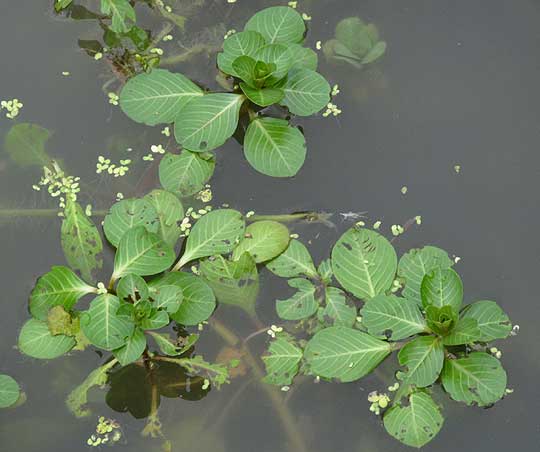
Another good field mark is that the leaves' herring-bone-patterned veins are so pale, and the midveins expand conspicuously toward their bases, reminiscent of chard leaves.
Floating Primrose-willow is native to tropical America and warmer contiguous zones, in the US occurring coast to coast in the southern two-thirds of the country. It's also spread as an invasive weed in much of the rest of the world's warmer parts, where its aggressive growth often gets it classified as a troublesome aquatic noxious weed. It can choke ponds and canals, and in large numbers can even lower oxygen content in water, which is bad news for fish.
However, Creeping Water-primrose has a certain talent that someday may cause it to be regarded as a highly honored guest in such treatment ponds as those around which Cook's Slough Nature Park is organized. That talent is that the plant absorbs toxic substances from the water, such as herbicides, pesticides, and pollutants. Once the plants have absorbed the toxins, then they need to be removed from the water and deposited where the toxins will do no harm.
entry dated July 7, 2022, issued from near Tequisquiapan; elevation about 1,900m, (6200 ft), ~N20.57°, ~W99.89°; Querétaro state, MÉXICO
FLOATING PRIMROSE WILLOW IN MEXICO
As seen above, we've already met the Floating Primrose Willow in Mississippi and Texas. In Mexico this mostly tropical species seems more at home, growing more lushly and thickly amid similarly robust Brazilian Watermeal, as shown below. That's in a local pond holding water during the whole dry season, because of runoff from irrigation fields not being closely watched:
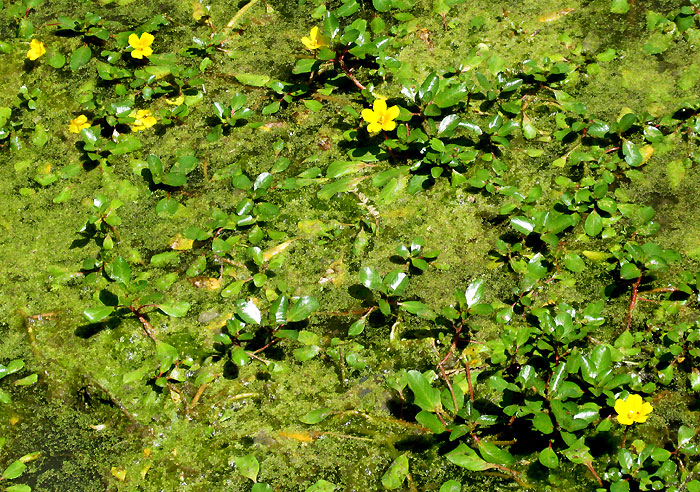
Here it is closer up:
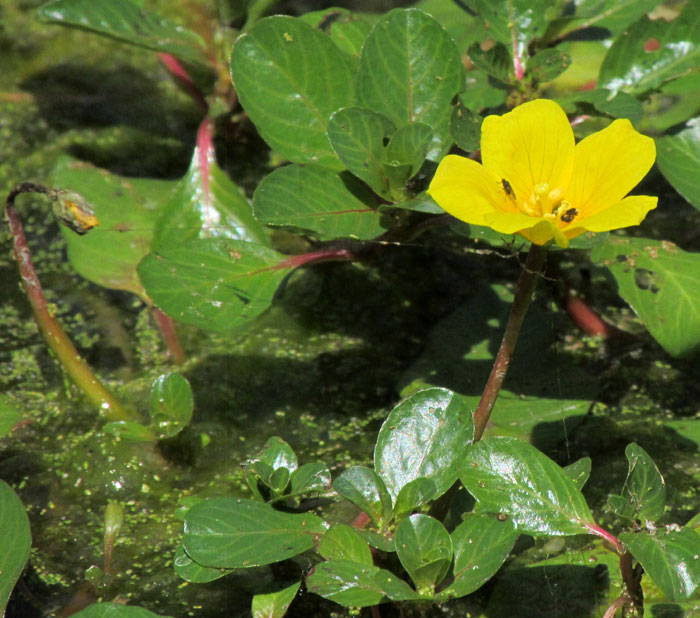
Not documented earlier is the flower shown from behind:
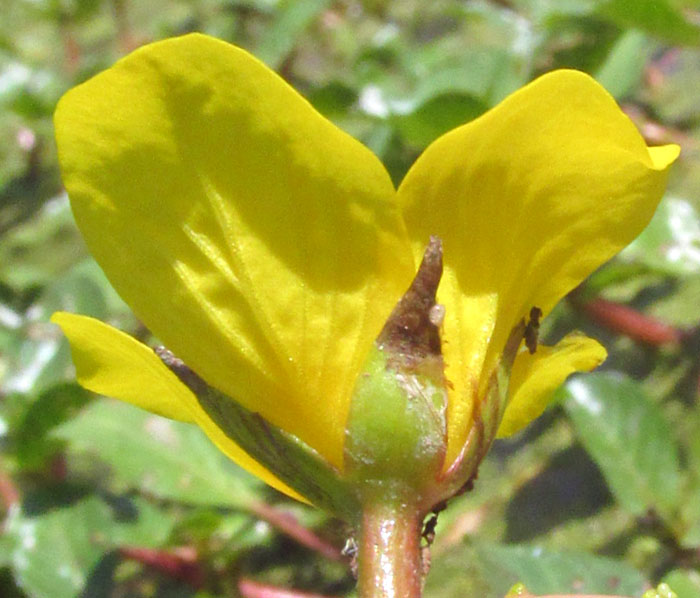
Below you can see how the blossom sits atop a sturdy, straight pedicel capable of holding the flower well above the water's surface. The pedicel arises from a submerged stem, which issues white, adventitious roots into the water around it.
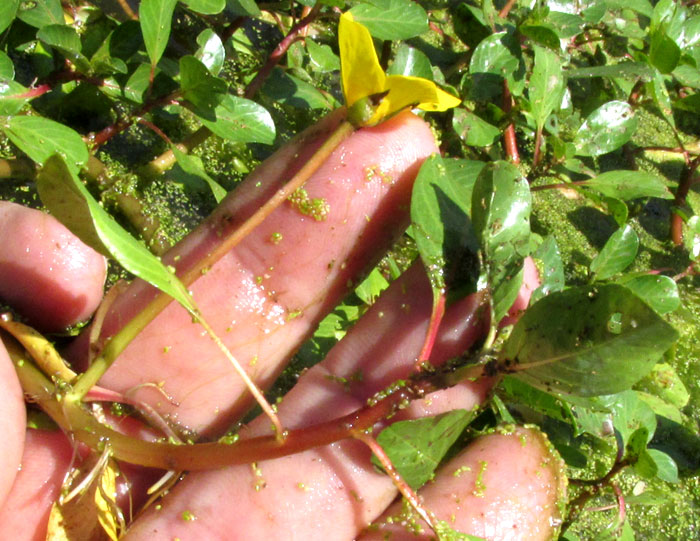
A 2018 study by Imen Smida and others entitled "Anti-Acne, Antioxidant and Cytotoxic Properties of Ludwigia peploides Leaf Extract," found that the leaf extract of this plant "... displays antioxidant and anti-acne effects as well as inhibition potential of B16 melanoma cells proliferation."
Because the plant grows so fast in warm climates, it's proposed as a good source of compounds of value in the pharmaceutical industry.
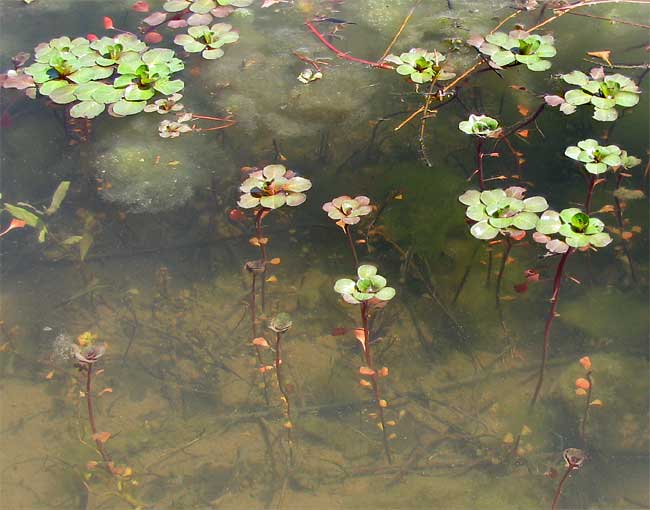
from the the March 23, 2009 Newsletter, issued from the forest near Natchez, Mississippi:
A DIFFERENT LOOK
Back in St. Catherine NWR (elevation ~46ft (14m), ~N31.41°, ~W91.46°) in clear pools of permanent water here and there you can find very interesting aquatic plants rooted in the mud. One of them is shown above.
At first I thought this was Water-Starwort, Callitrich heterophylla. Its green rosettes floating atop the water's surface, with the plant's surface leaves having a different shape and color from those on submerged stems is like a starwort. However, notice the alternating stem leaves, one blade per node; starwort stem leaves normally are two blades per node. Must be covergent evolution.
When you see these pagoda-like stems rising through clear water populated with all kinds of microscopic aquatic invertebrates showing up brilliantly in intense sunlight, you're charmed by the three-dimensionality and liveliness of the scene. You wish you could be like water fleas and paramecia diving and soaring through the water like shooting stars. Few environments fill one with a sense of Nature being so healthily and beautifully Herself as in the clear-watered aquatic habitat, and these primrose-willows are perfect citizens of that magical place.
Entry dated November 9, 2023, from notes taken at Cascadas de La Piedad waterfall 3kms NW of the community of San Pablo, municipality of Almeaco de Bonfil; N20.101°, W100.004°, elevation 2360 meters (7750ft); extreme southern Querétaro state, MÉXICO
WATER-STARWORT IN MEXICO
Just before cold water finishes streaming across pink andesite bedrock and silently drops into the canyon, a Water-Starwort was part of a composition of natural presences too pretty to analyze. Below, you are invited to meditate on the scene; it can be enlarged to 1000 pixels without losing definition.
